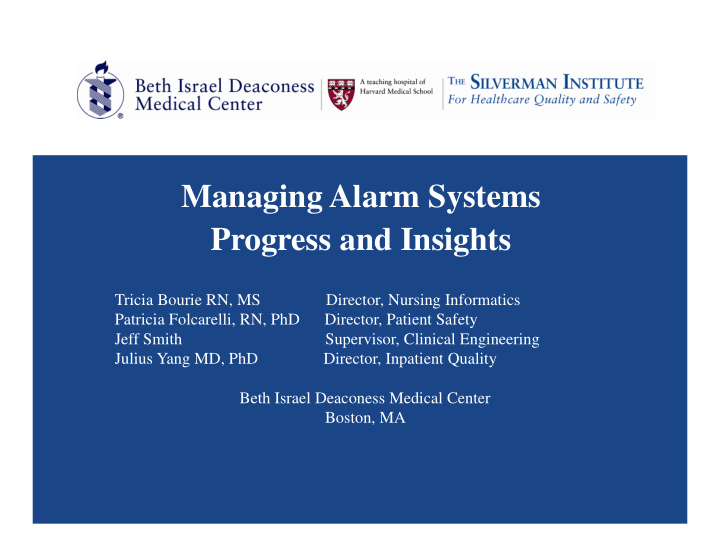



Managing Alarm Systems Progress and Insights Tricia Bourie RN, MS Director, Nursing Informatics Patricia Folcarelli, RN, PhD Director, Patient Safety Jeff Smith Supervisor, Clinical Engineering Julius Yang MD, PhD Director, Inpatient Quality Beth Israel Deaconess Medical Center Boston, MA
About us 621 licensed beds 6,100 Full-Time Equivalent Employees (Excluding Research) 4776 Births Level 1 Trauma Center and roof-top heliport • 41,125 Inpatient Discharges – 524,521 Outpatient Clinical Visits – 56,589 Emergency Department Visits – 318,335 Radiology Visits – 12,068 Inpatient Surgeries – 13, 929 Outpatient surgeries – 2,571 Inpatient cardiac catheterizations – 1,427 Out patient cardiac catheterizations – 22, 035 Out patient GI procedures – 22, 345 Radiation Oncology
About us 477 Med – Surg beds • 216 of these with telemetry capability 77 ICU Beds 25 Inpatient Psychiatry 48 NICU 64 Ante/Postpartum
Call to action • Event 1. Delayed response to monitored patient with pulseless VT: Desensitization to VT alarm • Event 2. Delayed response to monitored patient with asystolic arrest: Mistrust of telemetry signal • Event 3. Delayed response to cardiac arrest in patient whose monitor leads had fallen off: Apathy to leads off alarm • Event 4. Delayed response to cardiac arrest after monitoring suspended for off-floor procedure: Miscategorization of risk
Considerations…… • Standards and Policy • Education and Training • Human Resource • Technical/Equipment • Human Factors
Response to Life-Threatening Events Response to Monitored Events Response to Unmonitored Events Alarms / Device # Active Devices Response to Monitored Events (Alarms) 1 Total Number of Alarms Total Number of Alarms = (Alarms emitted by each device) x (# active devices)
Response to Monitored Events Alarms */ Device # Active Devices Non- Actionable Not Clinically Actionable Alarms Indicated Indicated Alarms False Alarms Nuisance Alarms Alarms / Device = (Actionable Alarms) + (Non ‐ actionable Alarms) * Technical Alarms and Clinical Alarms Non ‐ actionable Alarms = (False Alarms) + (Nuisance Alarms)
Response to Life-Threatening Events Response to Monitored Events Response to Unmonitored Events Continuous Alarms / Device # Active Devices Monitoring of High- Risk Patients Non- Actionable Clinically Not Actionable Alarms Indicated Indicated Alarms False Alarms Nuisance Alarms
False Alarms Recognized that false alarms (bad signal) often resulted from poor contact • Changed lead product after reviewing a number of types • Adopted new protocol to change electrodes daily
Nuisance Alarms Reviewed alarm parameters with MD electrophysiology expert • Modified unit default settings to minimize nuisance alarms • Piloted new settings on telemetry-dense units without adverse outcome • Adopted new settings as default parameters for all non-ICU inpatients
Alarm Default Changes Alarm 2004 New � 120 � 130 High heart rate Low heart rate <40 <35 Pair PVCs Off Off Missed beat Off Off Vent bigeminy Off Off Vent trigeminy Off Off
Alarm Default Changes Yellow Alarm 2004 New Non-sustained On Off VT Run PVCs >2 Off PVC rate >10 PVCs/min >15 PVCs/min Pause >2.0 sec >2.5 sec SVT >180 b/min >180 b/min
Alarm Default Changes Red Alarm 2004 New Asystole >4.0 sec >4.0 sec Vfib / Vtach >100 b/min >120 b/min Extreme Tachy >140 b/min >150 b/min Extreme Brady <40 b/min <35 b/min
Not Indicated Reviewed consensus guidelines for appropriate indications for cardiac telemetry Recognized that high proportion of telemetry monitoring inadvertently continued after “high-risk” condition had excluded or resolved • Re-designed electronic order for telemetry to include: • Required clinical indication • Daily re-order or discontinuation of telemetry
Continuous Monitoring of High-Risk Patients Recognized that telemetry monitoring occasionally suspended for “high-risk” patients when travelling off-unit • Re-designed electronic order for telemetry to include: • No option to suspend telemetry for “high-risk” indications • Telemetry suspension (for non-high risk patients) through structured order
Enhanced competency for response to Actionable Alarms •Developed and implemented baseline competency for cardiac telemetry interpretation •Developed tiered competencies for units with higher acuity •Reorganized committee structure to ensure collaboration among engineering team and clinical team members •Developed ongoing performance metrics for alarm response •Enhanced review of all cardiac/respiratory events to include intensive review of monitoring history/oversight
Summary of 2012 FY 2012 QUARTER MEASURE GOAL 1st 2nd 3rd 4th Telemetry: Response to “Leads 100.0% 95.6% 93.5% 96.6% 97.9% Off” Alarms within 3 minutes
Ongoing Challenges • Recent 30 minute Observation – Medical Unit • 100%of the time an alarm was sounding – Surgical Unit • 50 % of the time an alarm was sounding
Next Steps • Equipment Upgrade – Improved accessibility of data – Enhanced ability to customize alarm settings • Increase Number of Remote Displays • Continue to Refine Algorithms/Indications for use
Questions? Comments? • pfolcare@bidmc.harvard.edu • jyang@bidmc.harvard.edu • tbourie@bidmc.harvard.edu • jsmith6@bidmc.harvard.edu
Recommend
More recommend